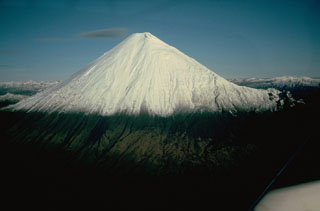Report on Sangay (Ecuador) — 8 August-14 August 2018
Smithsonian Institution / US Geological Survey
Weekly Volcanic Activity Report, 8 August-14 August 2018
Managing Editor: Sally Sennert.
Please cite this report as:
Global Volcanism Program, 2018. Report on Sangay (Ecuador) (Sennert, S, ed.). Weekly Volcanic Activity Report, 8 August-14 August 2018. Smithsonian Institution and US Geological Survey.
Sangay
Ecuador
2.005°S, 78.341°W; summit elev. 5286 m
All times are local (unless otherwise noted)
In a special report IG stated that a new phase of activity at Sangay began on 8 August, with surficial activity characterized by low-energy ash emissions rising as high as 2.3 km above the crater rim and a possible new lava flow on the SE flank. The Washington VAAC reported that prior to 1500 on 8 August an ash emission rose to an altitude of 5.8 km (19,000 ft) a.s.l., or 500 m above the crater rim, and drifted SW. On 11 August a possible ash plume rose to 7.6 km (25,000 ft) a.s.l., or 2.3 km above the crater rim, and drifted WNW. Thermal anomalies were identified in satellite data on 14 August. That same day a webcam image showed incandescence on the upper part of the SE flank, suggesting a lava flow from the Ñuñurco dome. The report stated that no activity at Sangay had been observed since the last eruption ended in November 2017.
Geological Summary. The isolated Sangay volcano, located east of the Andean crest, is the southernmost of Ecuador's volcanoes and its most active. The steep-sided, glacier-covered, dominantly andesitic volcano grew within the open calderas of two previous edifices which were destroyed by collapse to the east, producing large debris avalanches that reached the Amazonian lowlands. The modern edifice dates back to at least 14,000 years ago. It towers above the tropical jungle on the east side; on the other sides flat plains of ash have been eroded by heavy rains into steep-walled canyons up to 600 m deep. The earliest report of an eruption was in 1628. Almost continuous eruptions were reported from 1728 until 1916, and again from 1934 to the present. The almost constant activity has caused frequent changes to the morphology of the summit crater complex.
Source: Instituto Geofísico-Escuela Politécnica Nacional (IG-EPN)

